Apple Mac Pro (Mid 2010) Review
by Anand Lal Shimpi on October 6, 2010 9:26 PM ESTPerformance
The new Mac Pro is fast, but then again so was the old one. Earlier this year I tried using the 15-inch Core i7 MacBook Pro as my notebook and desktop - my experiment lasted all of a day, I missed the performance. It’s not so much an issue of peak performance, but one of core count and noise. While I rarely run applications that demand four (or more) cores, running a lot of applications that each eat 5 - 25% of a single core at the same time adds up. I also found that confined to a relatively thin notebook fans spun faster under typical CPU loads for me, as a result the overall system produced more noise than a larger tower.
I’ve got three Mac Pros represented in the charts below. The original late 2006 Mac Pro but upgraded to two 3.0GHz quad-core CPUs (effectively making it an early 2008 Mac Pro), the early 2009 Nehalem based Mac Pro once again upgraded to a pair of 2.93GHz quad-core CPUs and of course the new 2010 Mac Pro in its default eight-core configuration (2 x 2.4GHz quad-core CPUs).
Westmere only brought mild IPC improvements, so it shouldn’t really offer any tangible performance advantage over last year’s model. The only benefits will really be power, but let’s go down the list to put things in perspective.
Cinebench R10 & 11.5
Most applications won’t stress the 16 threads you get in the eight-core Mac Pro with the exception of offline 3D rendering of course. We’ll start out with Cinebench R10:
The single threaded shows how far we’ve come in single threaded performance just comparing Conroe to Nehalem. At roughly the same clock speed the 2009 Mac Pro manages a 25% performance improvement over the 2008 Mac Pro. Part of the advantage is obviously due to single threaded turbo mode, but it’s an advantage nonetheless. If you have a higher clocked Nehalem Mac Pro you’ll need to upgrade to something at least as fast as what you have now, the 2.4GHz default clock of the eight core system is simply too low to offer any advantage over the higher clocked alternatives in this chart.
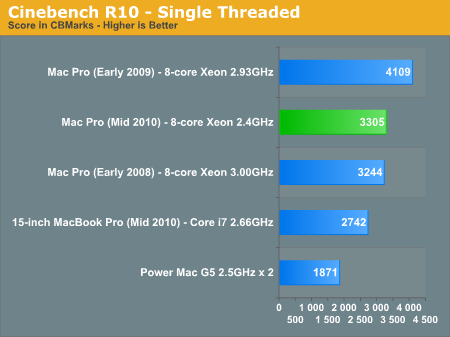
I also threw in the dual processor Power Mac G5 2.5GHz to put things in perspective. While a highly configured Mac Pro from 2008 may not be in need of an upgrade, if you’re still doing work on a Power Mac G5 an upgrade would be very appreciated. Westmere is 76% faster than the 2.5GHz G5 in this single threaded test.
Multithreaded performance scales very well on Nehalem and Westmere as you can see below:

The key takeaway here is that if you had a high clocked, eight-core Mac Pro from 2008 you can’t get away with the new 2.4GHz eight-core. The extra threads help but you need clock speed as well to manage a significant performance advantage over what you’re upgrading from.
The G5 comparison is even more ridiculous when we look at multithreaded performance. A single Westmere core running at 2.4GHz is nearly as fast as two 2.5GHz PowerPC 970FXes in Cinebench R10’s multithreaded test.
We see a similar story if we look at Cinebench 11.5 results:
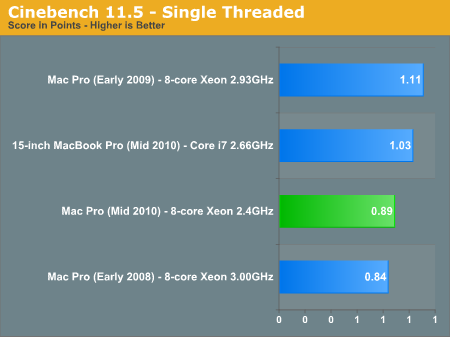
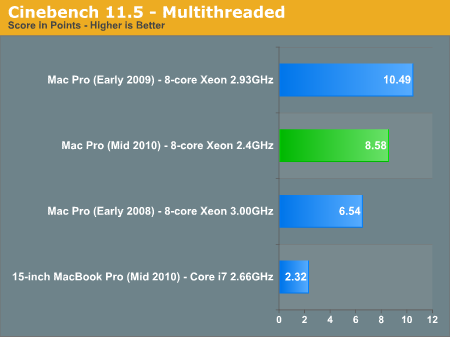
The newer benchmark is less bound by the performance of a single thread and thus we see it favoring the 2-threads-per-core you get from Nehalem/Westmere. In this case the 2.4GHz $3499 eight-core Mac Pro is faster than the 3.0GHz eight-core Mac Pro from 2008.
Remember that until Sandy Bridge, the L3 cache is the means of core-to-core communication in Intel’s Core series of processors. There was no single large shared cache in the 2006 - 2008 Mac Pro (each set of 2 cores shared an L2 cache) which is the reason for the relatively poor scaling there. Westmere gives you a larger L3 to play with and thus we see slightly better scaling from one to 16 threads vs. Nehalem. The size of the L3 cache in Westmere means that you can store more data shared by all of the cores in these heavily threaded applications.
Adobe Photoshop CS4 Performance
Photoshop is one of those benchmarks that really stresses everything. You get decent memory and I/O dependency and good use of multiple cores (but diminishing returns beyond 6 - 8 threads).
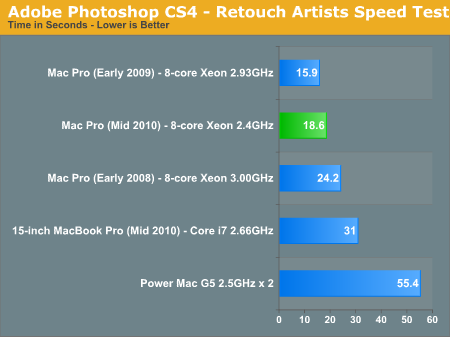
We’ve already shown the new Mac mini is nearly as fast as the Power Mac G5 in Photoshop, but the new Mac Pro cuts our test time in less than half compared to the old G5. The Westmere advantage is not tremendous here, some higher clocked Nehalems do better in this test.
Even the 2008 Mac Pro does well here, at least compared to the G5.
Aperture 2 RAW Import Performance
For my Aperture test I simply timed how long it took to import 203 12MP RAW images into the library.
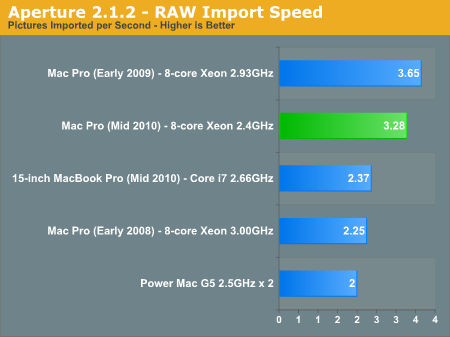
The 2009/2010 Mac Pros are very fast even in general use tasks like importing images into Aperture.
H.264 High Profile Transcoding
I have a feeling the transcoding game is going to get a lot more complicated after Sandy Bridge hits next year, but until then we’ve got our typical H.264 encoding tests. Here I’m taking a 90Mbps H.264 source file and transcoding it using Handbrake and the default High Profile settings.
The transcoding process peaks at about 11 threads, so there is an advantage to the Hyper Threading enabled systems but it’s not much. The sub-max thread count allows even the older 2008 Mac Pro to outpace the newcomer simply because of the system’s higher clocked CPUs in this case:
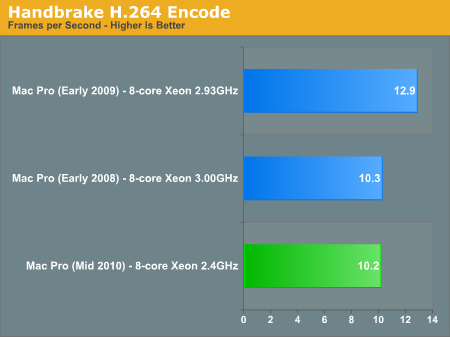
Clock for clock there is at least a 25% increase in performance over the old Mac Pro given the same number of cores. I wouldn’t expect a huge improvement vs. Nehalem at the same clock speed however.










84 Comments
View All Comments
tipoo - Thursday, October 7, 2010 - link
Sigh...For something aimed at content creation professionals, for something with up to 12 cores of epic performance...Apple sure likes to skimp on video memory. For instance, Mudbox will give you warnings and also slow to a crawl on the amount of video memory Apple provides, and your upgrade options are limited. 1GB is an improvement over last gen, but only squeaks by for high end graphics work. To make things worse, there are no build to order graphics options over 1GB.I guess people in that situation who don't need (or can't afford) a workstation class card will have to wait for a third party Mac graphics card with 2GB or more video memory.
AnnonymousCoward - Thursday, October 7, 2010 - link
Anand, I think you have a future in fashion show photography.chemist1 - Thursday, October 7, 2010 - link
Anand writes, in addressing one possible way in which this Mac might soon be obsoleted, "With the arrival of Sandy Bridge imminent, you might ask - why buy a Mac Pro today? And I might answer, Sandy Bridge isn't imminent for everybody."But isn't there a way in which the new Mac Pro is already obsoleted: the lack of onboard SATA III (6Gb/s) support? Given the importance of I/O for overall system performance, given that SSD cards are already capable of saturating SATA II connections, given that SSD cards should continue to increase rapidly in performance, capacity, and affordability, wouldn't one want to hold off buying a Mac Pro until it offers SATA III support (or something comparable to SATA III)—particularly also given that these desktops should have relatively long lifetimes?
Given Anand's sophistication about SSDs, I'm surprised no mention of this issue was made in the review—or am I missing something?
Nadav2010MP - Friday, October 8, 2010 - link
Sandy Bridge won't be out in XEON until if we are lucky... end of 2011- beginning 2012.. Sandy Bridge for consumer is on its way to being out now, but the server line of sandy bridge won't be until at least Q4 2011 to early Q1 2012. By then the mac pro might even be EOL, as it seems that Apple really is moving away from the pro-market and into an IPHONE/IPAD type of company.chemist1 - Friday, October 8, 2010 - link
Nadav2010MP: Unless there's some necessary connection between Sandy Bridge and Sata III (and I don't believe that SATA III is explicitly part of the Sandy Bridge specifications, but please correct me if I'm wrong), I think you've misunderstood my question. I wasn't asking about Sandy Bridge. Rather, I was just using Sandy Bridge as an example to ask: why mention only Sandy Bridge in discussing future potential obsolescence, when there appears to be a significantly a bigger obsolescence issue--the lack of SATA III?inzane - Thursday, October 7, 2010 - link
Any reason a similar configured PC running Windows 7 64bit was not included in the Photoshop CS4 test? Would like to see if there is a difference between Mac CS4 32bit vs Windows 7 CS4 64bit . Would the Win7 version benefit form the extra Ram, since a 32bit program only see 4 gigs?Nadav2010MP - Friday, October 8, 2010 - link
Dear Anandtech,Thank you for posting a review of the 2010 Mac Pro.. By now you have guessed that the 2010 mac pro is nothing more than a 2009 just with a updated firmware using the same logic board and same fans, and case design.. The GPUS also bring a difference, but not by much as the new GPUS work in all the Mac Pros 2010- down to 2006 :) But, this isn't the reason for my post.. I am about to tell you how I upgraded to the 2010 without having to shell out 4000.00 for a 6-core.. FIRST and foremost a minute or two about the CPUS...
The 2010 Mac Pro uses the following CPUS for its single-quad/6-core:
w3530 - 2.8/1066
w3565 - 3.2/1066
w3680 - 3.33/1333 - WE CAN ALSO ADD THAT according to Intel, the w3680 can use the following memory: 800 mhz DDR3/1066 mhz DDR3, and 1333 mhz DDR3..
However, here is where it gets interesting.. The following bloomfield processors allow for 1333 mhz memory:
w3570
w3580 - This is the processor I currently have with my 2010 set up. And yes, it supports 800/1066/1333 I will post a pic of my w3580 supporting 1333 mhz using a screen shot of a test 1GB 1333 chip under the new 2010 parts..
Now for the great news: You don't have to spend 4000.00 to enjoy a 6-core 2010 mac pro... in fact, you don't have to spend much at all.. Here is what I did.. Given now that Foxconn makes all the components for Apple instead of Intel(2006,2007,2008 mac pro logic boards), the backplane logic board that the 09 and 10 use are IDENTICAL to each other.. where one doesn't support westmere and 1333 mhz memory, the other does.. but they are virtually IDENTICAL in every detail.
Anyway, for 250.00(pricing varies by 50 at most) you can get the 2010 Backplane logic board and simply remove the 09's backplane. Also, you will need the processor board in order for the 2010 to work its magic, as both SMC's have to match for this to work. This board can be had for as little as: 46 DOLLARS!!!!!!!!!! and even 76 dollars(macpartsonline.com).. I have seen the processor board go for 249.00 and never higher than that.. There is also some good news:
Since the 09 uses the same parts as the 10, the HEATSINK for the single-quads from the 09 is identical to the one used on the 2010 :) More money saved!
So here were my specs for my original mac pro:
Mac Pro 4,1 with 8GB ddr3 1066 memory, w3580 processor, radeon 5770(sold my 4870 HD as this is not fully compatible due to a high sensor reading - others told me its because I had the 1st revision of the card, while a 2nd one does exist which fixed this problem.. but nonetheless, I got rid of my 4870 HD for 235.00 and it paid for the 5770 :)
Once I got the backplane and processor board, I immediately went to work creating my 2010 mac pro.. and it only cost me 300.00(250 - backplane 46 for processor board).. With this in mind, I used my existing processor, memory, hard drives, everything... here is the results: THIS IS FROM SYSTEM PROFILER:
Model Name: Mac Pro
Model Identifier: MacPro5,1
Processor Name: Quad-Core Intel Xeon
Processor Speed: 3,33 GHz
Number Of Processors: 1
Total Number Of Cores: 4
L2 Cache (per core): 256 KB
L3 Cache: 8 MB
Memory: 6 GB
Processor Interconnect Speed: 6.4 GT/s
Boot ROM Version: MP51.007F.B00
SMC Version (system): 1.39f11
SMC Version (processor tray): 1.39f11
How can you tell this is a 2010? Easy... SMC FIRMWARE: 1.39/F11(2009 was 1.39/F5). Bootrom is: MP51.007F.B00 where as the 09's was: MP41.0081.B08.
I plan to upload actual LIVE screen shots of my system profiler and also to put away the fact that the w3580 DOES INDEED support 1333 mhz memory.. I need someone to how me how to upload pics of this.. I really want to get this info out to EVERYONE who has a single 09 quad-core and wishing to move up to westmere... Now, should I decide to get the w3680, I can now do so since I have the parts in my 09 case.. 300.00 is all it takes to get the 09 to a 2010 :)
CONCLUSION:
I know a lot of you will have questions to ask me regarding about how to go ahead with this upgrade.. as I mentioned, anyone with a single-quad core from 09 series can easily do this.. Its not rocket science - the 2010 mac pro is nothing more than the 2009 just with a updated logic board to support 1333 mhz memory/westmere B1 stepping processors.. And yes, ALL D0 Bloomfield w35xx series processors work in the processor board of the 2010.
For the cost of 4000.00, I didn't feel the need to spend that much for a machine which is really a 2009 but with such updated firmware.. for this reason alone, for 300.00 I found the upgrade very enticing and I did it.
MeStinkBAD - Friday, October 22, 2010 - link
The following statement bothers me..."Update: Dell doesn't offer a Radeon HD 5770, instead you get a much more expensive FirePro V8700 graphics card. If deduct the street price for the graphics card from each machine, the Mac Pro ends up being $324 more expensive than the Dell. The Apple tax is there, but masked by the cheaper GPU."
You are basing this comparison on the cost of a component that is limited to the dell. And you state that they don't offer a 5770. Well if you choose to add a 5770, the price would increase on the Dell, the price of the Pro. It goes both ways. Doesn't matter if the Dell offers a higher price card. You may not need it. Does the Dell include the option to ship w/o a GPU? If so, that could be a valid comparison since you can not get the MacPro w/o a GPU. Even you don't need one.
The warrenty statement is also questionable. I have not had much experience w/ Dell's technical support. They used to basically tell you to send it away, they'd fix it, then return it. This costs nothing until the warrenty expired. Then they would charge you regardless of the problem, Apple on the other hand does indeed ask you to take it too the AppleStore.
But they won't charge you anything to take a look at it, regardless of the Warrenty. And if it's a simple software problem, they'll fix it and you can walk out without paying anything. The warrenty only refers to more complicated problems (almost always hardware related). Then you will be charged if the warrenty has expired.
I'm trying to be really fair here. Could someone correct me on this?
mlcatl - Sunday, October 31, 2010 - link
I can and have built many, many computers. But I don't keep spare parts around for a workstation like this (e.g. spare motherboard, etc.). Furthermore, I don't have the time to mess with it. I have deadlines and customers and I need my computer to work,With the Dell next business day warranty (which is extra), someone comes to your home or office and they have all the parts and they fix it without me having to drive somewhere. And they are professionals. No disrespect to the Apple Store Genius folks, they have gotten MUCH better in the last 4 years, but they still fall short of a enterprise maintenance solution.
My experience with the Apple Store, even with the Apple Care and an appointment. Lots of waiting, hauling my MacPro through the mall, etc.
I've had both Dells and Macs fail (motherboards, videocards, power supplies). Getting my macpro motherboard fixed (as it had intermittent failures) was a nightmare.
I've now moved into a job where I'm going to be windows only at work, so I'm getting rid of my OS X stuff and switching to a windows platform. I'm going to have to buy my own computer and the roll your own solution is very tempting. (yes I know about boot camp, but my Mac Pro 1,1 2006 requires hacking to run windows 7 64 bit. (
Ive loved my macpro and if I didn't need to run a lot of industrial strength stuff on windows, I would definitely be keeping it.
MeStinkBAD - Monday, November 1, 2010 - link
What the... you require a hacked version of Win7 to run on your 2006 MacPro? Are you serious? What did you do to it? Are you sure it's a MacPro? Not a hackintosh?Your experience is unlike any I've ever heard of... I mean if you we're having a motherboard failure they would have swapped the entire machine... and simply moved the hardware from the old machine to the new one. This is far more economical than actually replacing the motherboard, power supply, etc. Your previous machine would be sent back to Apple...